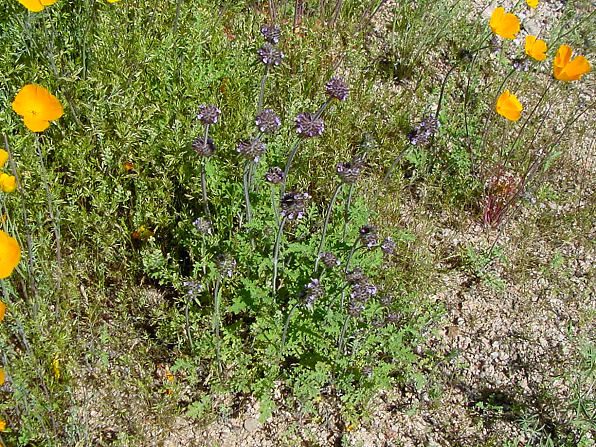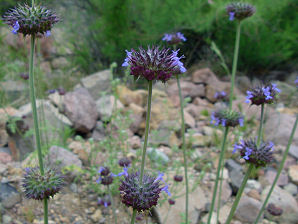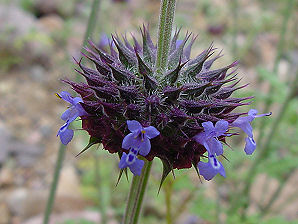Arizona Wild Flowers
Pictures, Photos, Images
Descriptions, Information, Reviews.
Chia, Salvia columbariae.
We Are Proud Of Our SafeSurf Rating!
Click On Any Of The Following Links By Amazon.Com
For Books, & Videos About Wildflowers Of Arizona & The Southwest USA. No Obligation!
 |
| Chia, Salvia columbariae Near Cave Creek, Arizona. March 10, 2005. |
|---|
 |  |
| Chia, Salvia columbariae. | Chia Flowerhead. |
|---|
Chia.
We wish to thank Wikipedia, the free encyclopedia for some of the information on this page. We share images and information with Wikipedia. To 20� tall, it makes large, globular, dark purple flower clusters that surround the stems. The two-lipped flowers are rather small, but are an intense deep blue. The foliage rosette is a pretty, gray-green and the leaves are quilted and deeply lobed. The edible seeds have a high-energy value & were used by Native Americans in bread concoctions & medicinally. Chia has medicinal and nutritional uses. This cooling drink was also famous for releaving a desperate thirst. Spanish Missionaries used it as a fever remedy and as a poultice for gunshot wounds.
Quick Notes:
Height: Growing to about 20 inches tall.
Flowers: Large, globular heads densely packed with numerous, very small, bilaterally symmetrical, pale blue flowers with glandular hairy calyces.
Flowering Time: March - June.
Leaves: The leaves are grey, basal leaves, forming a rosette to 2 1/2 - 3 1/2 inches in diameter, which is oblong to ovate in outline, deeply pinnatifid with crenate or lobed margins, and a bullate surface covered in long hairs.
Stems: Chia has square stems and a single stem has one or two pairs of smaller leaves. A large globular flower head is at the top.
Found: Native to the southwestern United States ( California, Nevada, Arizona, New Mexico ); and the extreme northwest of Northern Mexico ( Sonora, and Baja California ).
Hardiness:
Soil pH requirements:
Sun Exposure:
Elevation: Can be found from 0 - 3,900 Feet.
Habitat: Gravelly or sandy washes disturbed, or stony soils. dry undisturbed sites in chaparral, and coastal sage scrub. It prefers good drainage, sun, and dry weather. An ideal xeriscape landscape plant in Arizona.
Miscellaneous: Bottom Flowering Photos Taken April 07, 2004. Castle Creek, Arizona.
|
We Are Proud Of Our SafeSurf Rating!
Click On Any Of The Following Links By Amazon.Com
For Books, & Videos About Wildflowers Of Arizona & The Southwest USA. No Obligation!
| © 1966 - Present, Audrey, Eve, & George DeLange |
